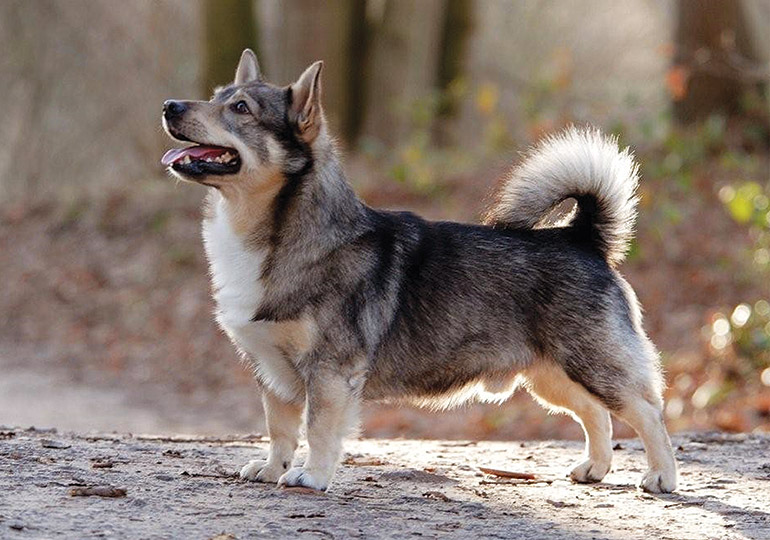Swedish Vallhund
Breed Details
Size:
Exercise Requirements:
Grooming Requirements:
9-16 Kg (Approx)
12-15 years (Approx)

Appearance
Small, powerful, sturdily built working dog, with a fairly long body. Appearance and expression denote a watchful, alert, energetic dog.
The Swedish Vallhund is a small, powerful, strongly built working dog with a low maintenance coat that may vary from bright red to wolf sable, with the majority being various shades of grey. The Vallhund has a natural or docked bobtail, therefore puppies born with tails may be docked.
Compared to the Pembroke Welsh Corgi, the Vallhund appears slightly higher on the leg and shorter in the back, with a free and active gait. The height from the top of the withers to the ground and the length from the breastbone to rear thigh of the Swedish Vallhund should be in the ratio of 2:3. The length of the chest cage compared to the overall length of the body is also in the 2:3 ratio.
He is sturdily built with moderate bone, which in the males, reflects masculinity without coarseness and in bitches appears feminine, without being slight of bone.
The correct texture of the coat should be viewed in its utilitarian aspect; to provide protection from the elements and other environmental conditions that the dog will experience under working conditions: Medium length, harsh, close and tight top coat, undercoat abundant, soft, woolly.
Colours are: Steel grey, greyish/brown, greyish/yellow, reddish/yellow, reddish/brown with darker guard hairs on back, neck and sides of body, lighter hair same shade of colour as mentioned above is desirable on muzzle, throat, chest, belly, buttocks, feet and hocks. Instead of these lighter shades, white markings are acceptable, but never in excess of one-third of total colour. Any colour other than the above, including white and blue or any non-standard colour, is highly undesirable.
History
The Swedish Vallhund is known in its native land as ‘Vastgotaspets’, which means ‘Spitz of the Wezt Goths’, and has existed in the middle and southern parts of Sweden for over 1000 years, although by the 1950s, due to dramatic circumstances, the breed was nearing extinction. The breed was saved due to the energetic efforts of one or two dedicated people.
The origins of the Vallhund are still shrouded in a great deal of mystery. Undoubtedly there is a connection between Corgis and Vallhunds, but whether Corgis were taken by the Vikings to Sweden and developed into the Vallhund or Swedish dogs brought to Britain and developed into the Corgi is not known. Being a working dog and a member of the Spitz family of dogs, the Vallhund bears a marked resemblance to the Pembroke type Corgi. On closer examination there are obvious differences, both types of Corgi are built very much closer to the ground and much heavier bodied than the Vallhund. The ear set, size and shape are completely different as well. Having much longer legs, the Vallhund is a far more active breed than the present day Corgi.
The Vallhund is very much a working breed and still works a great deal in Sweden itself. Being an active breed, they do well at obedience, love agility and are able to track.
The breed was established in Australia in 1981.
Temperament
The Vallhund is a smart and sociable herder of dense coat and boundless energy. These rugged cattle dogs are known for their zest for life, unique vocalizations, and cheerful demeanour.
Care/Grooming
Swedish Vallhunds need a good, down-to-the-skin brushing occasionally and a bath when they get dirty. They shed their undercoat twice a year, which will make you wonder just how many dogs you have.

